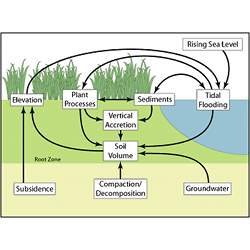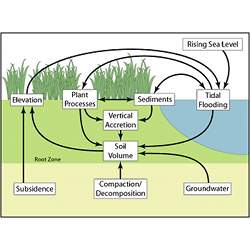
As the ramifications of a changing global climate become more evident every year, in phenomena such as record average temperatures and documented melting of polar ice caps, a growing number of scientists worldwide are advocating the use of nature to mitigate some of the expected damage to coastal communities.
Rather than rely exclusively on conventional man-made barriers such as dikes and sea walls, researchers are testing natural defenses featuring salt marshes and their complex habitat of grasses, soils, and sediment to help absorb not only the expected gradual rise in sea levels by the century's end, but also to help defend against short-term damage from surges caused by storms and floods.
Given the vast number of variables and uncertainties in trying to predict how much sea levels may rise, how, and where to best deploy marshes in coastal defenses, as well as how best to help those marshes thrive, some of the world's leading climate researchers are turning to flexible computer modeling to help them prioritize where marshes fit into the larger picture.
"No one is suggesting we rely exclusively on salt marshes to mitigate the effects of climate change," said Mark Schuerch, a post-doctoral researcher and coastal geographer at the University of Cambridge, U.K., specializing in salt marsh modeling. "It has to be seen as a complementary measure, which reduces the pressure on the hard infrastructure."
Schuerch's observations have been borne out experimentally by other Cambridge researchers; in the largest laboratory experiment ever constructed to investigate this phenomenon, a salt marsh reduced the height of large waves in deep water by 18%.
The approach has gone outside the experimental stage in other regions: in San Lorenzo, CA, for example, the Oro Loma Sanitary District has built a 400-foot wide "horizontal levee." The gently sloping wedge of gravel, mud, and grasses, which extends 200 feet into San Francisco Bay, mimics a historic wetland ecosystem that existed before settlement of the Bay Area. Treated water from the Oro Loma sanitary facility flows into the basin, is piped to the top of the levee, and flows through the soil to sustain 70,000 native plants. The levee serves two main purposes: the removal of excess nutrients before they get to the open water, as well as serving as an initial barrier against storm surge and flooding. A preliminary study exploring the benefits of such an approach estimated a combined marsh and traditional levee structure would cost about half as much per mile ($6.29 million) over the course of 50 years as a traditional levee alone ($12.5 million per mile).
Modeling for the Future
Accelerated sea level rise has introduced complementary reminders to coastal geologists and biologists: while marsh restoration has been a common practice for several decades, rising seas could flood recently restored habitats if they are at too low an elevation, killing not only marsh vegetation, but also wildlife such as shoreline-native birds. By forecasting possible sea level rise, those charged with building green coastal defenses can strategize how best to keep existing marshes healthy and where to introduce such marshes to habitats in which they may thrive.
Computer modeling is key to prioritizing such efforts.
Several well-known models are used by the salt marsh research community, including:
- Sea Level Affecting Marshes Model (SLAMM): First developed with funding from the U.S. Environmental Protection Agency in 1985, the open source model simulates inundation, erosion, accretion, soil saturation, and barrier island overwash. The latest update, SLAMM 6.7, was released in July 2016.
- Marsh Equilibrium Model (MEM): Developed by James Morris, director of the Belle W. Baruch Institute for Marine and Coastal Sciences at the University of South Carolina, MEM inputs include factors such as plant biomass as a function of elevation, relative marsh elevation, tidal range, rate of sea level rise, and suspended sediment concentration. It outputs a forecast of marsh productivity, relative elevation, and response to sea level rise.
- Dynamic Interactive Vulnerability Assessment (DIVA): DIVA is an integrated model that assesses biophysical and socio-economic consequences of sea level rise and socio-economic development taking into account coastal erosion and flooding, wetland change, and salinity intrusion into deltas and estuaries, as well as adaptation in terms of raising dikes and nourishing shores and beaches. Development is coordinated by the Berlin-based Global Climate Forum.
Ongoing model development is crucial as researchers learn more about sea level rise and which elements may be most critical in enabling marshes to maintain their health. Trying to apply a model universally—in fact, finding a starting point for a model—can be problematic, especially in regions which have not had historically significant rates of sea level increase.
For example, along the coast of New England in the northeastern U.S., historic rates of sea level rise average between 2 and 4 millimeters a year, according to Jonathan Clough, founder of Warren Pinnacle Consulting, which does the bulk of SLAMM maintenance.
"If you take the historic marsh accretion rate, they're about the same, so you wouldn’t predict any marsh loss on the basis of sea level rise alone," Clough said. "Yet some of our clients in Connecticut and New York say, 'we do have historical marsh loss; is your model wrong?' There are a lot of compounding factors that come into that, such as nutrient enrichment in Jamaica Bay (in New York City), boat traffic, and other types of contamination in the water that might be causing a dieback. There are a lot of factors that can cause marsh vulnerability."
Morris said the models also help dispel the common misconception that sea levels are going in one direction—"sea level rise is not this simple, orderly, monotonic linear process people imagine, it bounces around a lot around a trend line"—and can help those tasked with establishing and strengthening marshes to optimize the habitats for marsh plants to grow and bolster their natural defenses against inundation. For example, he said he has discovered marsh grasses may thrive best at an elevation slightly higher than the present "optimum" elevation, given projections of sea level rise in coming decades, and that fertilizing marshes can actually help them keep up with the seas.
"When they are too high, they are too dry and osmotic stress hurts them," he said. "If they are too low, hypoxia (inadequate oxygen) gets them; they drown. If a marsh is actually higher than the optimum, that's a good thing–when the ocean rises, it effectively lowers the relative elevation of the marsh a little bit, and they respond positively to that. They grow better and produce more roots and rhizomes, which makes more volume in the soil, raises the elevation of the soil, and traps more sediment. Modeling tells us how important sediments are to the process by which marshes maintain elevation. It also informs us how important productivity is in the marsh–a lot of marshes are nutrient-limited."
Chris Elphick, an associate professor in the department of ecology and evolutionary biology at the University of Connecticut, is working on numerous projects along the east coast of the U.S. He said the models are a valuable part of his work in trying to protect vulnerable shorebirds whose very species' existence depends on marshes' adaptability to sea level rise.
"Things like SLAMM and the other models can help us understand which marshes are likely to persist and which are not," Elphick said, "and that can help us be more efficient in terms of where we put resources. You don't want to do some of these more extreme management methods in places where it's completely hopeless; you want to identify the places where it will work and do the most good, and the models help us do that."
Gregory Goth is an Oakville, CT-based writer who specializes in science and technology.




Join the Discussion (0)
Become a Member or Sign In to Post a Comment